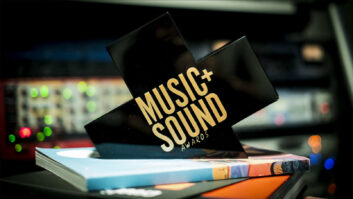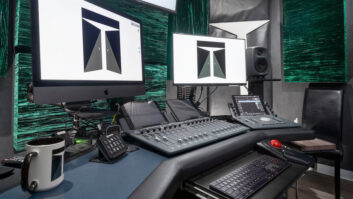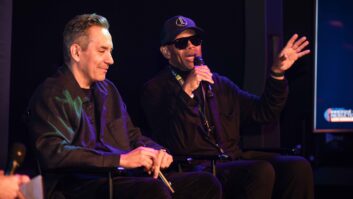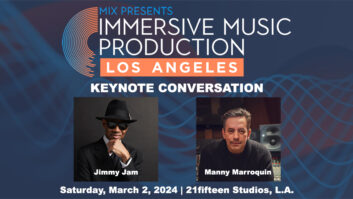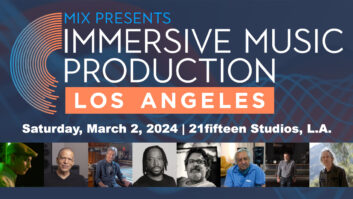Linda Ronstadt, Dolly Parton and Emmylou Harris could hardly believe they were finally all seated at the large Elektra Records conference table promoting Trio II. The project had been halted in 1994 near the completion of mixing, and the follow-up to their successful 1987 album had remained shelved until now. The specific reasons for the delay are still vague, but they supposedly had something to do with the impossibility of coordinating three separate artists’ contracts and schedules. So Ronstadt never thought her label would agree when she suggested they resurrect this record to help fulfill her own contract.
“It was the same mess they didn’t want to deal with originally-different labels, different managers and the same can of worms all over again,” Ronstadt explains. “Plus, Dolly had taken her tracks and put other harmonies on them, and I had taken my tracks and done the same thing. But I said to the label anyway, ‘Would you be interested in our reassembling this record in the way it was originally recorded and putting it out?’ To my complete shock, they said yes.”
“I didn’t think it would come out until after we were dead,” Harris says. And Parton adds with a laugh, “It’s like a good bottle of wine-it’s been aging. I was so excited when I got the message about the record getting released I’d been praying ever since we stopped it that it would come out because it was so great.”
Parton’s busy schedule hadn’t permitted her to attend a few of the earliest sessions at the homey rural studio known as The Site in Marin County, where producer George Massenburg tracked the initial sessions. “It’s very complicated because you really want the vocalist to be there when you set up the tracks to make sure you’re starting off in the right direction-particularly the key, but also the timbre of the track, to make sure you’re supporting the vocal well and to make sure the song is being well-represented,” Massenburg explains, adding that Alison Kraus subbed for Parton on “I Feel the Blues Movin’ In” so they would be sure of the vocal parts and the instrumentation that would surround them. “On the first record we had some instances where two girls would sing their parts and we’d end up challenged to invent weird parts to make a third part; the second part ‘jumped’ so much. It would be almost impossible to find a third part.”
Since they weren’t able to cut the three voices together, Massenburg says, the objective was to make it sound live. Microphone choices assisted in the challenge. “We used several modified U67s with sub-micron Stephen Paul capsules. I used Mastering Lab mic preamplifiers, and GML compressors and equalizers. We did do a little bit of tuning vocals, but only very reluctantly. Where we did it, we did so because we felt it was essential to a beautiful harmony blend.”
Even being the known perfectionist she is, Ronstadt says she’s as much a fan of the Trio’s otherworldly vocal blend as the people who buy the records. “It always takes my breath away,” she notes. “Me, too,” Parton agrees. “It’s a thrill. And it’s not from any place of an ego thing. I feel humbled to be on it, and when I hear it, I feel so many emotions that I cry.”
“What we didn’t have were years on the bus and onstage together singing, so we learned to phrase together and anticipate each other’s phrasing,” Ronstadt says. “That’s what took the time in the studio to work out. It doesn’t have to be perfectly in tune, but we all have to be singing to the same pitch center. When that happens, it shimmers, and I kept looking for that shimmer.”
Though the singers usually have a basic idea where each voice fits in the triad, it is still a process of trial and error on each track. “When we get in the room, we try different configurations to figure out what’s going to work the best,” Harris notes. “There are no rules. It’s just, what is the best thing for the song? That even pertains to who should sing lead-the song decides it. We would bring a song in not thinking in terms of, ‘Oh, I’m going to sound great singing this.’ We were thinking of the Trio. The Trio becomes an entity, and the focus is, ‘What facet of the Trio is this song going to bring out? What configuration of voices is going to make this song shimmer?’ I’m sure Dolly didn’t bring in [Neil Young’s] ‘After the Gold Rush’ with the idea that she was going to sing lead. She just loved the idea of the song. Linda and I felt that Dolly’s voice was the one that was going to give it the most spooky quality.”
“Linda and Emmy always work so well together that I totally respect what their opinion is on a song, and they know how to use me wisely,” Parton adds. “I brought in ‘After the Gold Rush’ thinking I would be doing the high part because they love to hear my high part.”
According to Massenburg, that song presented them with one of their biggest challenges: “We didn’t realize it until we had recorded it, but we felt that Neil Young’s original lyrics had to change. Everybody has kids, and nobody wanted to say ‘and I felt like getting high.’ ‘Felt like eating pie’ was one replacement suggestion, but that didn’t work out,” he says with a laugh. “And the reference to ‘in the 1970s’ was changed to ‘in the 20th century.’ We had to do the fixes after we had done the vocals, and matching up vocals like this perfectly is never easy. The other thing about that song was that it was really ‘outside.’ We hadn’t done anything like that before. It’s the opposite of a country radio record in every respect.”
But the notion of cutting “hits” was not a major factor in this project. From the get-go, they believed the music would probably not be serviced to radio (they turned out to be wrong). “We didn’t have a lot of radio support for the first album, either,” Ronstadt comments, “but we sold a lot of records, and people found out via word of mouth. And it was the kind of thing where connoisseurs of acoustic music liked where we had taken the tradition. I think when you establish tradition in whatever you do-I call it hooking up to the ancestors-and the music reflects all the people who were responsible for putting you where you were emotionally, culturally and intellectually, the music becomes sacred. The three of us had a lot of that to offer. Dolly, particularly, focuses it because she is the legitimate Appalachian deal. It’s music that Emmy and I both have studied, admired and emulated and done as much as we can to capture, but when we have Dolly there with us it becomes a great big thing because she brings an authenticity to it that is just stunning.”
Massenburg says he found the lack of radio concern refreshingly liberating, and the production choices reflect that: “It’s not recorded or mixed the same way a radio record would have been. With very beautiful voices, it allowed us to retain the detail. We didn’t have to make them too loud or perfectly even. They could breathe a little and retain some degree of life. When you’re trying to appeal to radio, you generally compress the hell out it, and by God, I feel like I’m an expert in that, but here we didn’t have to do that. All we had to think about was making a great record with great tunes that would flatter the voices. We didn’t find ourselves saying, ‘This would sure sound good on radio,’ or ‘We’d better have an electric bass on this because we want it to read on radio.’ We found we made choices for the right reasons.”
There was more freedom in the choices in instrumentation as well, and they were able to give the tracks an “old-timey” feel. “What that means is the sounds don’t have to be saturated. The sounds don’t have to be huge and over-compressed, and the acoustic instruments could be delicate and rather small,” Massenburg explains. “We approached the first record in a little more old-timey fashion-we had more dulcimers and David Lindley instruments, but we had our share on this one as well. Sam Bush was supposed to play on the album, but the morning he was to leave Nashville, there was a huge ice storm. He walked out to go catch the plane and fell on the ice and broke his elbow or wrist. We very quickly had to get a stand-in, who was David Grisman. Some stand-in. Among many other strengths, he has the best tremolo in the business. He’s a great musician and has a solid sense of that old-timey music.”
“One of the reasons I was so anxious for this record to come out was that the players gave their best,” Ronstadt says. “We had the best players of acoustic music. There might be others as good, but there aren’t any better in the world that you could find. They would give up these beautiful little pearls. There are exquisite little internal harmonies that the fiddle player or the mandolin player would play. David Grisman is particularly good at that. He might shadow a line of Emmy’s or Dolly’s that would be a melody line and nobody really would hear that except us, but it’s part of the whole thing. The musicians took care of that music like it is sacred music, and it is sacred music.”
Hiring the musicians was one of Massenburg’s responsibilities, but he says, “The girls have a very clear idea of what they love, so I’m there to enforce what and whom they choose. If I can help by making suggestions, great, but I’m there to execute what they want. If somebody says, ‘That guitar doesn’t sound very good,’ I fix it, fast. Or if Linda says, ‘I want a Rickenbacker’-the old Byrds 12-string, which is an awful piece of junk that cannot be tuned-[guitarist] Dean Parks and I may choose a more modern version that actually can be tuned. Linda wanted that sound, but that’s where we might exercise choice.
“Certainly I’m there to book musicians and coordinate schedules, which is a huge job and takes technical, musical and political chops. My role is to do what nobody else wants to do, whatever that is at the time. And I believe that is the main role of a producer. It can be to make clear what someone else can’t verbalize, or it may be to order lunch. The producer’s job is, and always will be, to clean up the rear. And I’m proud of it,” he laughs. “I enhance the artist. And I don’t want to leave fingerprints. There are some producers who like to leave a big mark, but I’m the opposite. If I change the sound of an act or an artist, I’m not doing my job.”
In this particular case, reassembling the tracks five years after they had been recorded was also part of the job. “We had to find stuff in the warehouses,” Ronstadt recalls. “When we took the record apart [both Ronstadt and Parton borrowed tracks for solo projects while the Trio album was dormant] we all changed the harmony parts around so they existed on backup reels, but they weren’t in completed forms. We had to find all those reels and reassemble the way the harmonies had been and re-combine them. That was a lot of work. Poor George had to track those down. He’d play me stuff over the phone and I’d go, ‘No, there used to be a part that would go this way,’ and it was hard.”
“That happened one or two times where I hadn’t identified the right cut and it was clearly something where we had remixed it, so I had to find it,” Massenburg says. “It was on Sony 9000 MO discs-unfortunately an obsolete recorder-and we just had to find the right things, but it was pretty well-documented. The most we had to do was editing. We put it in a Sonic Solutions workstation and edited between mixes quite a bit.”
Massenburg says, “The track I probably like the best is ‘You’ll Never Be the Sun.’ It’s stunningly beautiful, and that happened one morning before Linda got there. Mark Casstevens played a gut solo on it, which he tried to improve, but never could.”
“‘You’ll Never Be the Sun’ was the one that really just kept haunting me during the five-year period,” Ronstadt adds, “and also the mandolin harmony David Grisman played on ‘When We’re Gone, Long Gone.’ There were things where I just felt, ‘This record has to come out.’ The last record the three of us made together and this one are the projects I have participated in that have most fulfilled the goal set. When you set out to make a record, you hope that it’s going to satisfy certain aspirations that you have, and these two records really succeeded in what we set out to do. I’ve made a lot of records where I didn’t feel that way. And I probably feel that way the most about the ones that were most [commercially] successful. It’s like, ‘Ughhh, that sucks!’ It’s really hard for a project to match the dream, but this one did.”
“It’s a lot easier for me to listen to this record than to my own records,” Harris says. “But I like to listen to this, because the Trio is its own entity.”
“Listening to mine, I find all kinds of faults and I’m thinking, ‘I should have done this, I should have done that,'” Parton notes. “But everything is perfect on these albums. I’m prouder of the Trio albums than anything I’ve ever done.”
